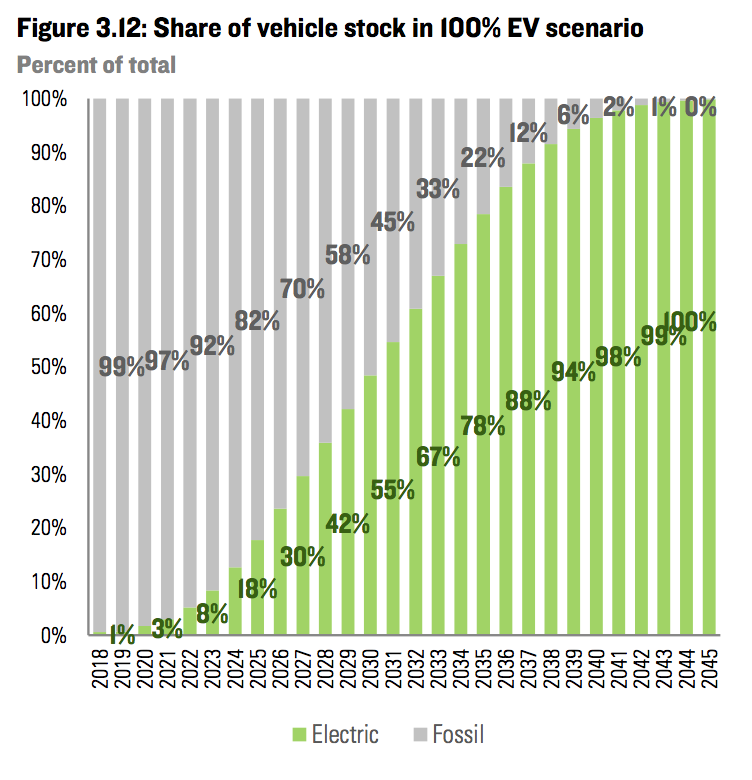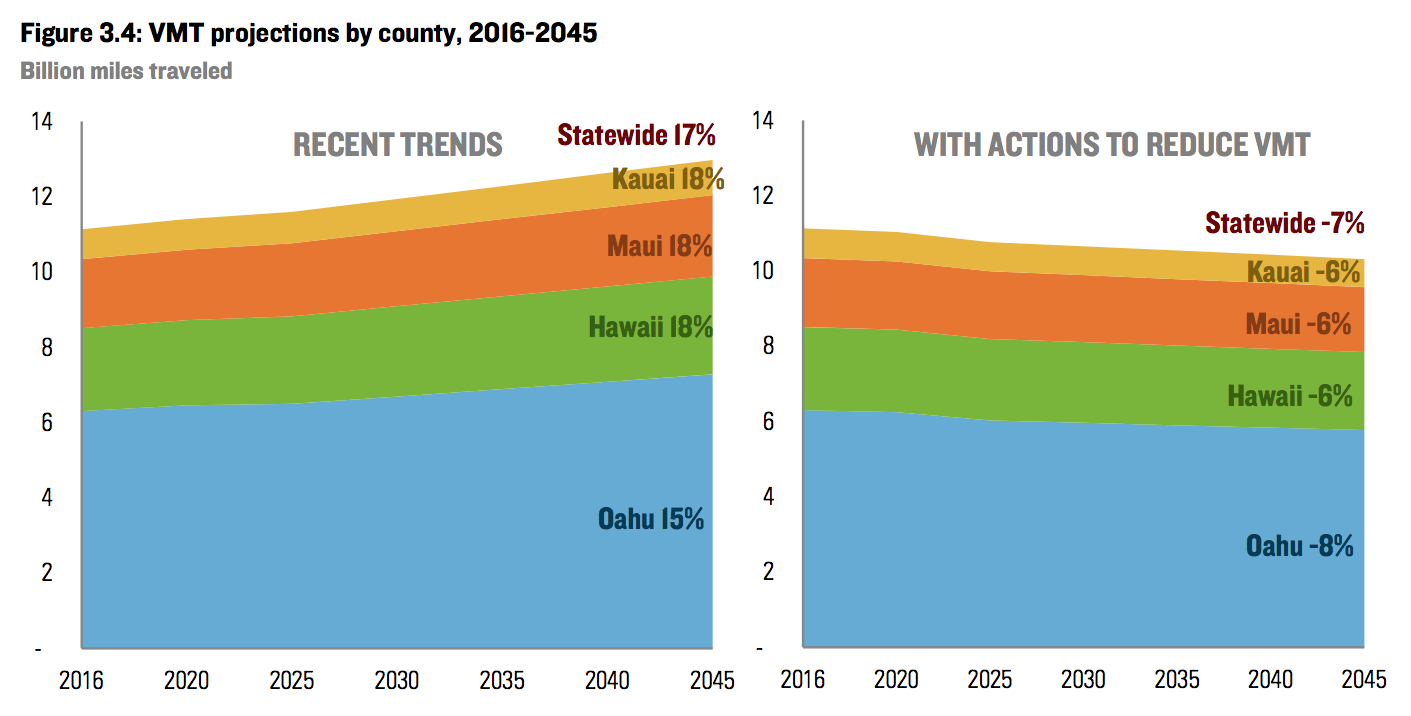
News
By Smart Growth America, April 20, 2018
Ten years ago, Hawaii set ambitious goals to reduce their dependence on imported oil and create a clean energy future by 2045. But when it comes to their transportation system, Hawaii has to look beyond just electrifying their vehicle fleet or finding cleaner sources of energy. Smarter land use will reduce the length and frequency of car trips, and encourage more walking, biking, and transit use.
The Hawaii Clean Energy Initiative is charting a new path toward an energy-independent future for Hawaii. Today, imported oil supplies 80 percent of Hawaii’s energy. Our dependence on oil threatens our most precious resources—the land, air, and water that sustain us. And it places our economic security at risk. Simply stated, our current way of meeting our energy needs is not sustainable. Hawaii must alter its course.
Hawaii leaders and residents have a vested interest in both reducing their dependence on foreign oil and also finding cleaner sources of energy. Ten years later, on Earth Day 2018, how can Hawaii continue moving toward this vision? What are the key changes required, and what can the state to do make it happen? To analyze what it would take to get Hawaii to a clean energy future by its goal of 2045, The Elemental Excelerator turned to Smart Growth America and the Rhodium Group.
Download the report
Transcending Oil:
Hawaii’s Path to a Clean Energy Economy
What did we find?
If Hawaii did manage to shift to an all-electric vehicle (EV) fleet—included in our recommendations—but continued growing in the same form as today, the energy grid would need to produce one-third more energy than it does today. The power industry will already be struggling to find enough renewable energy without having to add such a large load. But if they pair EVs with building more connected, compact, mixed-use development with improved facilities for non-auto travel, vehicle miles traveled would go down by over 20 percent from what is projected, making it easier to meet Hawaii’s clean energy goals and saving people money.
 To make the shift to clean energy, Hawaii needs to convert all vehicles to electric, such as today’s Nissan Leaf or the Ford Focus Electric. But no state can make this happen overnight, as the lifespan of a new car can be about 15 years. That means even if Hawaii required 100 percent of vehicles sold in the state to be electric by 2025, it would still take until around 2040 to see the fleet turn over from gas/diesel engines to EVs. And electrifying the fleet would be a monumental challenge. Hawaii would only have the authority to do this by joining California, who through a federal waiver has the authority to set their own vehicle emissions standards. Otherwise, fuel standards are controlled by the feds—standards that the Trump administration recently announced they’d like to roll back.
To make the shift to clean energy, Hawaii needs to convert all vehicles to electric, such as today’s Nissan Leaf or the Ford Focus Electric. But no state can make this happen overnight, as the lifespan of a new car can be about 15 years. That means even if Hawaii required 100 percent of vehicles sold in the state to be electric by 2025, it would still take until around 2040 to see the fleet turn over from gas/diesel engines to EVs. And electrifying the fleet would be a monumental challenge. Hawaii would only have the authority to do this by joining California, who through a federal waiver has the authority to set their own vehicle emissions standards. Otherwise, fuel standards are controlled by the feds—standards that the Trump administration recently announced they’d like to roll back.
Compounding the problem, during that time period, Hawaii would also need to build out the infrastructure needed to fuel and charge all of those EVs, including a way to pay for transportation maintenance and improvements when there is no gas left to be taxed.
An all-electric fleet is only as clean as its energy sources
The Clean Energy Initiative aims to reduce petroleum use for transportation, which today accounts for two-thirds of the state’s overall energy use. In order for Hawaii to reach their clean energy future with an all-electric fleet, all of the energy used to power those vehicles would need to come from clean sources—solar, geothermal, wind, etc.
Even still, with no other structural changes, the net energy required would increase. If Hawaii kept growing and developing across the state in the same form, an all-electric fleet would add a 33 percent load to the electric grid in Hawaii.
Clearly, more is needed than just producing cleaner vehicles powered with cleaner energy sources.
Reduce transportation energy demand by pairing these changes with smarter growth
One reason the transportation sector uses so much energy is because we’ve put people’s homes far away from all the things they need—like jobs, groceries, schools and medical care. We don’t have to do this: we do this by choice.
This development pattern leaves residents little choice but to drive—usually alone. Rarely are two neighbors’ destinations located close together with everything so spread out. This drives the cost of living up by essentially requiring most people over the age of 16 to own a vehicle just to participate in the economy. Imagine that: a $10,000 cover charge to enter our economy. We want everyone to be able to participate in the economy, especially those that don’t have $10,000. Yet we exclude them in the way we design and build our communities.
Don’t be fooled—the free market did not create these conditions. In fact, prices in walkable communities with amenities near homes are worth a premium these days. But the supply of homes in these places doesn’t even come close to keeping up with demand. And our zoning codes prohibit the types of development seen in many of those in-demand neighborhoods that save residents money and cut down on fuel use. We require big houses set back from the street, separated from other houses with lots of parking and no amenities nearby. We engineer the “flood of traffic congestion” that results from all of it.

Just think: changes to state or local zoning codes would allow more traditional development where apartments are close to townhouses and single family detached housing, where houses are close to retail, restaurants, groceries, parks and schools. All types of households—young, single, married, seniors—could all spend less on transportation and put more money into retirement/housing/education/savings, and we could easily use less energy.
Reducing the demand for energy through smarter growth will help Hawaii make all its energy renewable and clean. This is the future we are encouraging for Hawaii—and indeed the rest of the country. Read our full report to see how it can be done. While Hawaii is unique, there are more lessons in common with the other 49 states than not.
Related News

© 2025 Smart Growth America. All rights reserved
Site By3Lane Marketing










